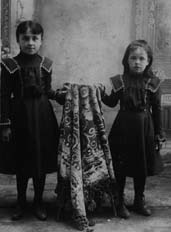 |
Anderson/Egeness Genealogical Information |
|---|
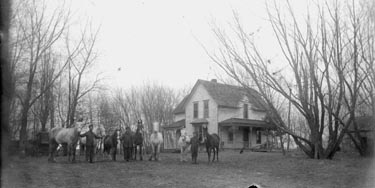
This is the original Egeness homestead in America. The farm was bought from the Chicago North Western Railroad by Andreas 0. Egeness in 1885, when he built this home, 1 mile south and 1-1/4 mile east of the Village of Frost, Minnesota.
August Egeness, son of Andreas, bought it in 1928 from his father's estate. Otis Egeness, oldest of the August Egeness children, bought it in 1975 from his father's estate for $1,250 per acre. Lester Egeness, youngest of the August Egeness children, bought it in 1981 from the estate of his brother Otis, for $2,007 per acre. At this time he sold the building site to his son, Paul, who is the great grandson of the original owner. This house is still standing today. |
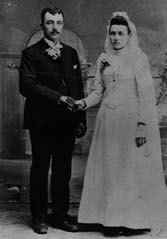 |
Olaf Christian (Egeness) Anderson and
Magrethe (Margaret) Leiter Anderson Wedding Picture
At South Blue Earth Church Bricelyn, MN |
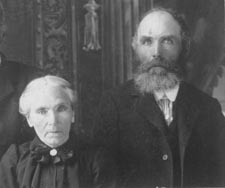 |
Anna Olsdatter Bergsetter Egeness and Andreas Olsen Egeness
|
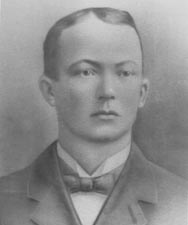 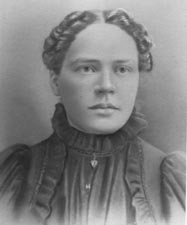 |
August A. Egeness and Hilda Bertina Berge Wedding Pictures
in Frost, MN |
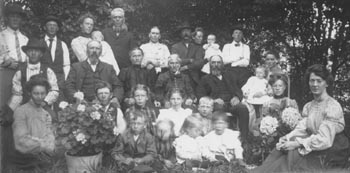 |
Egeness Family around 1900-2
Top Row Left to right
second row
third row
four children in front are unknown |
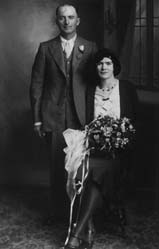 |
Arthur Anderson and Emma A. Starry Anderson Wedding Picture
|
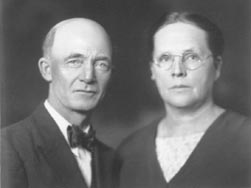 |
August A. Egeness and Hilda Bertina Berge 50th Wedding Anniversary
|
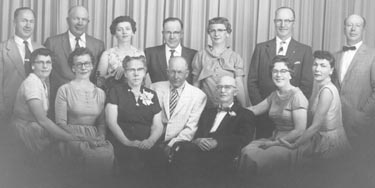 |
August A. Egeness and Hilda Bertina Berge 60th Wedding Anniversary Family Picture
June 10, 1959
Top Row Left to right
Bottom Row Left to right
|
This article was shared by Lester and Mavis Egeness. August and HiIda Egeness are Lester's parents, the son and daughter-in-law of Andreas and Anna Egeness, and the brother and sister-in-law of Ole and Margaret Anderson.
From the Blue Earth Post August and Hilda Egeness - 1958 A Senior Salute FROST COUPLE, WED 59 YEARS HAVE MUCH TO BE THANKFUL FOR Mr. and Mrs. August Egeness have quite a lot to be thankful for as the new year approaches. It was more than 60 years ago in this season that the two began their courtship. Hale and hearty, they will observe their diamond anniversary in another five months. They have been blessed with 12 children, all of whom are living, most of them in this area. The traditional Egeness family get-together will be the Christmas Eve supper. If all the children return home as planned this Christmas there will be 45 persons in attendance. There are 28 grandchildren and three great grandchildren. When they were married on June 10, 1899, he was 21 and she 19. It wasn't a particularly long courtship, and in fact as teenagers they had never met, even though the farms on which they were born and raised were only 1-1/2 miles apart. They might just as well have been 50 miles distant, explains Mr. Egeness. At that time most of the land upon which they lived was covered by water. The Egeness family referred to the Berge family as "those folks who live across the swamp". Mrs. Egeness is the former Hilda Berge, daughter of Mr. and Mrs. Ole Berge. Her grandfather, Hermund Sime, acquired the 160 acres of land where she lived from a homesteader for the price of a pair of boots. But it wasn't all bargain, since only 25 acres of the farm was above water. The Egeness farm, pioneered by August's father, Andreas (Andrew), had about the same percentage of tillable hand -- 60 of the 200 acres. But today all the swamp has been drained leaving rich farm land, nearly all of which is under cultivation. Otis Egeness now farms the "home place" where his parents live, and Lester works the Berge place. Both are located a short distance south of Frost. The difference in the two farms when August and Hilda were born were the buildings. August was born in a small house (10 by 14 feet) which is used as a shed today. The future Mrs. Egeness was born in a spacious home known in the early days as "Henry's (Sime's) Church". Being one of the larger edifices in the area it was used for meetings, school and church services. August Egeness' father was a blacksmith by trade. He came from Norway, went to Madison, Wis., then arrived in Wells, Minn., (the end of the rail line) in 1871. With $3 in his pocket, four children, a wealth of Norwegian tongue but no English, he had to find someone to talk to. When he found another Norseman who could understand him, he was immediately informed that smiths were in great demand and referred him to a farmer in Rome Township where he could be employed. He set up shop for the farmer on the banks of the Blue Earth River near where Frost now stands. (That village wasn't born until 1899 with the arrival of the railroad). Later he bought the first 80 acres of the present Egeness farm, moved a small building to the place to house his family of five. August was born here February 13, 1878. "It was on Friday, incidentally", comments August, "but I've never found Friday the 13th particularly unlucky". August recalls that as a young man the favorite shopping center was the village of Clayton located about five miles to the east of the farm. All legal business had to be transacted there because Clayton had a Justice of the Peace. "We could get groceries there and medicine"", he recalls with a chuckle. "The 'medicine' was mostly alcohol for internal use. It was given a fancy name to make it a cure-all". August doesn't look upon himself as a farmer. At 16 he began running a threshing rig and stayed with the occupation 48 years. He has also sawed "Millions" of board feet of lumber, ran a ditching machine with horse power, and was a butter maker at a creamery located between Frost and Elmore in 1904. Something of a jack of all trades, he estimates that he moved 500 houses in his time, using his favorite form of power, the steam engine. Almost every town in the area with the exception of Wells, have buildings that he has moved. Many farms in the area have buildings constructed from the lumber he sawed -- some of the farms built 100 percent from Egeness lumber. In his biggest season he cut a half million feet. Another thriving village. Egeness recalls from his younger years, is Blaine, located about two miles east of Frost across the section from his farm. Blaine had two stores, a blacksmith shop, post office, creamery and feed mill. The blacksmith ship is still in use, moved to the Egeness farm and converted to a hog house. It is interesting to note that while modern refrigeration didn't come into being until 1930, the first automatic refrigeration ever used in the county was the product of the ingenuity of the Blaine creamery operator. Decidedly unhappy with the yearly project of cutting and hauling ice for summer use, this man employed gravity and a flowing well to eliminate that unpleasant task. The river was below the creamery. He installed a pipe system from the well, through the creamery cooling room and down to the river. In this simple manner, ice cold water was siphoned through the building all summer long and ice never had to be used again. August has a 'pet' on his farm -- a monstrous 12-HP steam engine once used with his threshing rig. It may be described as a classic, in top-notch repair it "purrs like a kitten". He hopes to fire it up sometime this year and invite neighbors in to watch as he cuts lumber. Another steam rig, also in good running condition, was sold to an Odin man late this summer. Egeness had bought it at near junk price. fixed it up and made a rather neat profit on the sale. The Odin man took it home, hooked it up to a threshing rig, and charged 25 cents for people to watch it work. Though they have lived in the Frost area all their lives, Mr. and Mrs. Egeness have taken several trips through western states and into Canada, and as August put it 'quite a few trips into Frost' where they do nearly all of their trading. Thanksgiving Day plans are undecided, but with so many of their children in the area they hardly think they'll pass the day without the traditional feast. |
This article was shared by Lester and Mavis Egeness. August and Hilda Egeness are Lester's parents, the son and daughter in law of Andreas and Anna Egeness, and the brother and sister in law of Ole and Margaret Anderson. Old Grandma Hilda Berge Egeness Written by JoAnn Roberts Hannaman She sat quietly sewing. Sewing with a needle that wasn't there, on a quilt in her mind. Her hands were never idle, always busy , working sewing, crocheting, never idle. This was my grandmother , Hilda Bertina Berge Egeness, now at 94. I first remember my dear grandmother as a soft Iap and a hug for hurts, with a scolding in the right places. Her smile was shy and girlish and her laugh quiet and lady-like. Her will and spirit was strong, and her inner strength seemed endless. I never really remember her ever showing great sadness, except at the death of my grandfather, August. Even then, her inner strength bore her up. Grandmother didn't always have an easy life. She was born in 1880, on a farm in Southern Minnesota. She had three brothers and three sisters. When she was twelve her father died. Grandmother often talked of her beloved father whom she missed terribly after his death. When her mother re-married her life changed for her. She and her step-father never got along. So when she was about fourteen, she went to work as a mother's helper. She always had to take her pay home to her step-father, or he would go and collect it. When her employer found out what was happening, he requested, rather forcefully, that he never collect it again. She kept her pay from then on. When grandmother was 16, she met a personable young man named August Egeness. Though they lived only one mile apart, she had never met him before. Her family being the wealthier of the two, cautioned her about "that family that lived across the swamp land." Never the less, they met at a church social and from this came a courtship and a love that lasted all her life. It brought her thirteen children and sixty-one years of marriage. Grandmother married Grandfather on June 10, 1899. They moved to forty acres of land that Grandmother inherited from her father's estate, on the stipulation that she and her husband care for her Uncle Matt Seim until his death. Now Uncle Matt was more than a handful. He was quite on in years, stubborn and though he was blind, insisted upon doing everything by himself, although he was many times incapable of doing this. Now the farm Grandmother lived on was near a much traveled road, and on this day, I remember her speak of, it was quite busy. It was a warm summer day and a perfect one for bathing Uncle Matt, who would not bathe himself. Grandmother left her baking to call Grandfather, from his work in the barn to do the job. Matt needed much convincing, as bath time did not seem to be his favorite past time. Finally, Grandfather got him to the wash house, settled him in the wash tub and proceeded to wash him. Forgetting the soap, he had to return to the house to get it. In the meantime, Uncle Matt decided that enough was enough. So he climbed from the tub, searching for a towel. Unable to find it, he donned only his hat and belt and walked to the house naked. Oh, the hoots and whistles and hollers that came from passing buggy riders. My poor Grandmother had a terrible time facing the meeting of the Ladies Aid Society. My grandfather traveled a lot in his work, house moving, sawing lumber, threshing with his thresher and steam engine. This left many lonely days and lonely nights for my grandmother to pass, to say nothing of farm work. I'm sure they had help from hired hands at times, but she always did a lot of work beside her husband in the field, besides doing housework and raising children. She even took the children to the field with her. One lovely summer day, just right for weeding, she took Otis, her first born, to the field with her. She took a cradle box for Otis, and a hoe for herself. She placed the cradle box at the end of the row with the baby in it. This way she could always look back and see that he was safe. She checked him each time she returned to row's end. She took the second precaution of leaving her dog Shep to watch the child. After hoeing for some time, she looked back at the cradle box . Giving a cry of terror she ran with the stride of a sprinter toward the box. Over the box stood Shep, rigorously shaking what appeared to be the baby. She screamed at the dog and scolded, but upon reaching the cradle she found a dead snake lying on the blankets. Shep had killed it. Another time when grandfather was gone, a peddler came to the door selling his wares. Being close to evening and the supper hour, she offered him supper. When he found the man of the house was not home, he decided he would stay and promptly sat by the fire with his feet up. Grandmother could not get him to leave. Finally she turned to Shep, who had followed the man in the house, something he had never done before, and said, "take him, Shep". The man left rapidly, almost leaving the seat of his pants behind and no thought for his dignity. This gave grandmother a real scare, but a good story to tell Grandfather when he came home. Grandmother wasn't always working outside. She worked in the house, too. She was a superb cook, cooking all the Norwegian dishes her family loved, and sewing, always sewing and crocheting. I remember the table cloth she won a Champion Ribbon at the County Fair. It's mine now. I remember seeing her cut a pattern out of old newspaper or store wrapping paper and using this pattern to make a dress for me. I was always amazed at her skill. And her grape jellies and jams, and the trips to pick wild grapes were adventures in themselves. Her house was never without the inevitable sugar cookie and doughnut. She was a coffee drinker, always. Coffee for breakfast, for morning lunch, for lunch, for afternoon lunch , for supper, this Norwegian home always needed coffee. And Christmas, oh joyous time, all the family together, aunts, uncles, cousins, all. Always there was a Christmas tree, chicken, dressing, gravy , mashed potatoes, vegetables, pies, lefsa, lutefisk, kringlas, rosettes , potato cakes, snow for sliding, carols for singing, apples and of course, coffee. But best of all there was joy, laughter, happiness, programs and love. Love of family, but mostly love of our Savior. There never was a time that the Christmas Story was not read. It was usually read by my Aunt Esther and the whole family listened again to the wonderful telling of our Savior's birth. My grandmother was a deeply religious person, and with the help of my grandfather, passed this to her children and grandchildren. I lived with her and my grandfather and my parents on their farm until was five. She helped me with my Sunday School lessons many times and taught me, along with my grandfather, a deep and abiding love of God, and a love of music. She used to tell me of riding to church in a horse and buggy and of spending all day at the church. First there were services, then a picnic dinner with family and friends, and finally another service late in the afternoon, before everyone left for home. She enjoyed the telling as much as the memory of going. Grandmother was always willing to hear my small problems and my new developing ideas. One day, during a violent thunder storm I insisted she move from sitting in front of the old wall telephone, as she might be hurt. After much discussion and pulling and shoving from me, she moved across the room. Upon leaving her spot, a ball of electrical fire shot across the room and scorched the wallpaper on the other side. She never forgot this sign of God's protection and care of her and made it an extra lesson for me. Her lessons for me were important, but my mother has told me that her lessons were even more important to her children. Usually she helped with love, but sometimes her help came in a more material way, as when she was disobeyed and had to punish someone. My mother told me about a time when she had misbehaved and was to be spanked. My resourceful grandmother had her go outside and choose her own spanking stick. She of course chose one that would hurt as little as possible. Grandmother was watching from the kitchen window and saw her testing spanking choices. Upon her return for the punishment, grandmother gave one whack with the stick and broke it. Now she proceeded to choose her means of punishment, namely a willow stick. Needless to say, my mother learned a lesson from this: never try to escape your punishment by trying to fool your mother. If my grandmother was good at lessons, grandfather used to tell me she would make a great star, too. He liked to tell about the time she vaulted a six foot fence to save Uncle Matt . It happened like this. Uncle Matt, who was always independent, decided this day was a good day for helping herd the cows into the barn. Now usually Grandmother kept a close eye on Uncle Matt, as did Grandfather, but today he escaped her notice. He slowly groped his blind way closer to the barn and the cow pen. He found the fence and slowly found the handle to what he thought was the cow pen, but it was in fact the gate to the pen of the vicious bull my grandfather had. He opened the gate and went in. In the house my grandmother heard the loud bellowing, and missed Uncle Matt, guessed what must have happened. She ran full speed toward the tall six foot fence surrounding the pen. Putting her hands on the top rail, she swung her legs up and vaulted that fence. She grabbed Uncle Matt, who gave no resistance now, and dragged him to safety. She never seemed to be able to figure out how she was able to do this, for she could never do it again, she said. Another strengthening from the Lord. She bore thirteen children, and only one died in child birth. In her later she lived with her oldest son, Otis. Now Grandmother, who was growing old, still thought of him as a boy, worrying when he was late from town or the field. Worrying about this seventy year old "boy", she would go out looking for him on the farm. Because her family loved her and worried about her use of the stove and her wandering about the farm she loved, they placed her in a home for senior citizens, where she could receive better care. She had many friends there and great care. When she had been there a while, she slipped and fell, breaking her hip. From then on, she was either in a wheel chair or bed ridden. When my little family and I came to visit her, she always held the babies, and hugged the older ones, petted them, kissed them and loved them all. She might forget my name, but she never forgot to love. I remember now how she sat quietly sewing on a quilt that wasn't there, with a needle not visible and asking me to stay for lunch when Grandpa came in from the field. But behind it all, I remember the loving dark-haired woman who helped me grow to be a woman myself, who gave me love and enriched my life and that of my husband and children. She's gone now, but everyone in my little family remembers, "Old Grandma" and loves her. |
This article was shared by Lester and Mavis Egeness. August and Hilda Egeness are Lester's parents, the son and daughter in law of Andreas and Anna Egeness. The following unfinished story of the married life of August and Hilda Egeness, was written by August sometime in the last months of his life. He passed away in April, 1960 of cancer. THIS SHOULDN'T HAPPEN TO ANYONE In the year of 1898 there was a young couple planning to get married. They planned their wedding to cost $90.00 and rented an 80 acre farm. The groom had worked so he had $190.00 coming. The wedding date was set. He quit his job and proceeded to collect these wages and found that his employer was broke and he never got that money. They did not know what to do and in desperation the groom went to a near by town, saw the banker and told him all about having rented a farm and needed $100.00. To the grooms surprise the banker said "I know your father, you shall have the $100.00". The groom really got surprised. He did not know that his face looked good enough to borrow $100.00. Well, the wedding went on and they had a very nice time, but there was a hitch. A man that had tried to marry the bride's mother done a very good job of telling the groom's father that it was a forced marriage. He went to the minister to have it annulled, but the minister took care of that . Period. The wedding was over, the farming began. By second thought, the day before the big day there had been a big rain so that the well had gotten full of water. The groom had to get up early in the morning and bale the well empty so the water could be used. They raised wheat and that was of poor quality and the price went to 49 cents a bushel. The field was so wet that the groom cut swats through the fields so the binder could go through. They had 4 cows on shares which brought them about $4 a month for their share. They got a cow given to them by the bride's mother. The cow had a calf and they both died, but they had about 30 chickens. Sold eggs at 12 cents a dozen. Then came haying and stayed home and put up the hay. That crop was safe. The next morning the meadow had about 2 feet of water on it. Then came threshing and the groom had to go out and run the steam engine at $2 a day so they could eat, but the engineer did not get paid. The next year they went into the hog business. They raised 40 hogs and were doing fine. When the corn was gone, the hog cholera came and then they died. They decided to quit farming, sold the machinery and worked around where he could get something to do. Wages were 75 cents to $1 a day. Then he went to Hastings, Minnesota (his brother, Ole Anderson had moved to Hastings in 1900), and worked at the carpenter trade until the 4th of July and came back with $67.00. That was 1903. He worked the harvest and ran a steam engine through threshing. In 1904 he worked doing spring work. In May of that year he got a job in a creamery as second man. After the first three days there was given the Buttermakers job. He (the buttermaker) was interested in the fair sex and wanted to be in the weight room so he could talk to them. Every afternoon the groom worked for the farmers in the harvest at 75 cents per day. That fall they moved to a place owned by her Grandfather and he was going to his father's place to get the horses shod and then he got a telephone call to come back home. The barn was on fire. They had all their winter feed and a colt and one calf. It all burned. The winter went on as usual. The next spring he got a job with a ditching machine. In 1906 he went along with a man and bought a threshing machine and a new sawmill, but the partner wanted to be the bookkeeper. In about two years there had not been very much paid on the outfit and it was put up for sale. The agent bought it back. The partner told me we owed $400.00 only, but it was $1,800.00. The dealer asked him to take it over on half earning contract. They made a deal. It took him three years to pay it off. Then the separator was worn out so he had to get a better one. There was one to be gotten but they wanted $700.00 and he did not have that much. He went to the dealer and told him he would give $400.00 for it and if he could make the deal he would give him $50.00 for his work. The next day the agent came to the house and told the wife to tell the man to go and get that machine and go to work. From that time things, by the help of the good Lord, began to look up. In a year or so they had three threshing rigs going. They threshed and sawed and moved buildings. About 500 buildings. The grain threshed, he would not even say how much. Forty-eight years was spent on this work. Then he was offered a job at the flour mill at Blue Earth to run the engine at $47.00 a month and a little overtime for Sunday. But houses were hard to get at that time. There was one that could be bought for $1,800.00 --and there were four kids to feed, so he decided not to take the job. He was very glad he did not take the job as the mill just ran a few years and folded up. The three engineers all died on relief. A year or two later he and a brother-in-law (Alf Alfson?) bought a half section of land in Marshall County, Minnesota, (near the South Dakota border) and paid down $800.00 on it and rented it to a Russian guy and when they came to collect the proceeds of the crop they found the fellow had threshed the crop and pulled into Canada, no one knew where. A county ditch came through and the taxes got so high we couldn't make it -- so lost it. Then his father died (Andrea Egeness 6 Nov. 1915) and he was chosen Power of Attorney. He rented it to a couple of guys for $1.800.00 a year. The land rental was high at that time, but he only got $900.00 and he had to pay ditch tax and other taxes out of his pocket. The next year he Jet them have it on share rent. That was not any better. Then the heirs began to want the farm sold, so three of them started action to sell the farm. One of the party was to get $1.000.00 and when they came to settle he demanded to get $3,500.00. One-eighth of $62.00 an acre bid and the other heirs followed suit, so the land cost him $8,660.00 to satisfy the heirs. A mortgage of $10,500.00 was on the farm, so it cost a total of $19,660.00 for the land and $750.00 retirement taxes on the ditch. The farm was priced at $62.00 an acre. This finished, then came the home that was his wife's farm, or that had been her Grandfathers property, at that place they were living at the time it came up for Probate. There was somewhat of jealousy from some neighbors. They bid $75 and $80 an acre so they got it at that bid. From that time it moved along fairly good. After a while came the Depression and hard times. They had a lot of custom work beside farming and had to take a loss of about $1,700.00 on bad accounts. Some went bankrupt and had no way of paying. Then the mortgage on the farm was due and they thought they would lose the whole thing. Some very good friends got the Federal Land Bank interested and they gave them the Loan in 1934. From then on it gave them a chance to look up. Now there were 6 boys and 6 girls. Some took up farming and some got themselves an education and took the easier way. Some have made a good account of themselves. some not so good --. It has taken a lot of patience. It has not been their works, but a higher Power that has done it. The land has been paid for and the children have their homes. There has not been everything inherited. What the family have is by the help of God and work. It is proven that one should not jump at what hangs high, but stay on the job. It might not look too bright at times, but there is always a rift in the clouds and all is right again. They are now old and shall not be here much longer, but they are glad for the time and blessings the good Lord has given them and that the whole family is here. There have been many mistakes for which they are sorry for, but things gone by there is not much one can do about it. They are now retired and live on their parents Homestead. The house he was born in is still standing and his wife's home is there too. They are thankful that they have always been in the same Congregation where they were Baptized and Confirmed and married and where their parents are buried. There are only two of the eight sisters and brothers yet living (August and Lena -- they died within 4 days of each other). They have 28 grandchildren and 7 great grandchildren. The old neighbors are mostly gone, which brings many happy memories to mind. When one thinks back they were good neighbors and they miss them. It might be interesting to go back to the old neighbors that come to mind. Their closest neighbor was a man by the name of John Hermingson ------ |
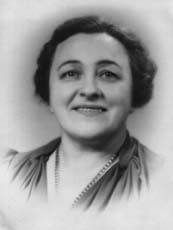 |
Ora Amelia Anderson Wescott
Born: January 26, 1892; Wells, MN; Faribault County Married Wells Jay Wescott on December 1, 1915 in St. Paul, MN; Ramsey County Died: April 12, 1946; Minneapolis, MN; Hennepin County |
|
Obituary of Andrew 0. Egeness
Obituary of Mrs. Andrew Egeness (Anna Olsdatter Bergsetter) Obituary of Mrs. Olaf C. Anderson (Magrethe Leither) In Memory of Otis Egeness |
This Page was last updated on January 22, 2002 |